
Tree-kangaroos are marsupials of the genus Dendrolagus, adapted for arboreal locomotion. They inhabit the tropical rainforests of New Guinea and far northeastern Queensland, along with some of the islands in the region. All tree-kangaroos are considered threatened due to hunting and habitat destruction. They are the only true arboreal macropods.

The glossy ibis is a water bird in the order Pelecaniformes and the ibis and spoonbill family Threskiornithidae. The scientific name derives from Ancient Greek plegados and Latin, falcis, both meaning "sickle" and referring to the distinctive shape of the bill.

The spur-winged goose is a large bird in the family Anatidae, related to the geese and the shelducks, but distinct from both of these in a number of anatomical features, and therefore treated in its own subfamily, the Plectropterinae. It occurs in wetlands throughout sub-Saharan Africa.

The yellow-necked mouse, also called yellow-necked field mouse, yellow-necked wood mouse, and South China field mouse, is closely related to the wood mouse, with which it was long confused. It was only recognised as a separate species in 1894. It differs in its band of yellow fur around the neck and in having slightly larger ears and usually being slightly larger overall. Around 100 mm in length, it can climb trees and sometimes overwinters in houses. It is found mostly in mountainous areas of southern Europe, but extends north into parts of Scandinavia and Britain. It facilitates the spread of tick-borne encephalitis to humans and is a reservoir species for the Dobrava virus, a hantavirus that is responsible for causing haemorrhagic fever with renal syndrome.
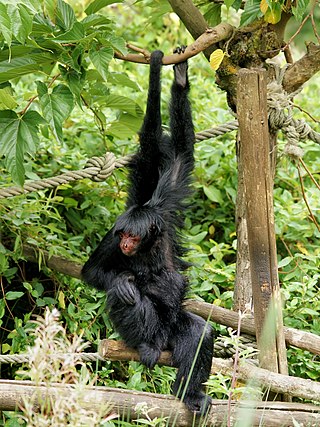
The red-faced spider monkey also known as the Guiana spider monkey or red-faced black spider monkey, is a species of spider monkey found in the rain forests in northern South America.

The little red flying-fox is a megachiropteran bat native to northern and eastern Australia. The species weighs about half a kilogram, one US pound, and is the smallest species of Pteropus in mainland Australia. P. scapulatus occurs at the coast and further inland, camping and flying to the tropical to temperate regions that provide them with an annual source of nectar. They exhibit an unusual method of obtaining drinking water during dry periods, skimming a stream's surface to gather it onto their fur while they are in flight.

Dryocampa rubicunda, the rosy maple moth, is a small North American moth in the family Saturniidae, also known as the great silk moths. It was first described by Johan Christian Fabricius in 1793. The species is known for its wooly body and pink and yellow coloration, which varies from cream or white to bright pink or yellow. Males have bushier antennae than females, which allow them to sense female pheromones for mating.

The hemlock woolly adelgid, or HWA, is an insect of the order Hemiptera native to East Asia. It feeds by sucking sap from hemlock and spruce trees. In its native range, HWA is not a serious pest because populations are managed by natural predators and parasitoids and by host resistance. In eastern North America it is a destructive pest that threatens the eastern hemlock and the Carolina hemlock. HWA is also found in western North America, where it has likely been present for thousands of years. In western North America, it primarily attacks western hemlock Tsuga heterophylla and has only caused minor damage due to natural predators and host resistance. Accidentally introduced to North America from Japan, HWA was first found in the eastern United States near Richmond, Virginia, in 1951. The pest is now found from northern Georgia to coastal Maine and southwestern Nova Scotia. As of 2015, 90% of the geographic range of eastern hemlock in North America has been affected by HWA.

Cleridae are a family of beetles of the superfamily Cleroidea. They are commonly known as checkered beetles. The family Cleridae has a worldwide distribution, and a variety of habitats and feeding preferences.

The dark long-tongued bat is a species of bat from South and Central America. It was formerly considered the only species within the genus Lichonycteris, but is now recognized as one of two species in that genus, along with the pale brown long-nosed bat. It is small species of bat, with adults weighing 6–11 g (0.21–0.39 oz) and having a total length of 46–63 mm (1.8–2.5 in).

The northern pika is a species of pika found across mountainous regions of northern Asia, from the Ural Mountains to northern Japan and south through Mongolia, Manchuria and northern Korea. An adult northern pika has a body length of 12.5–18.5 centimeters (4.9–7.3 in), and a tail of 0.5–1.2 centimeters (0.20–0.47 in). The pika sheds its fur twice annually, bearing a reddish-brown coat in the summer and grayish-brown coat in winter. It feeds on various plant material and makes "hay piles" for winter use.
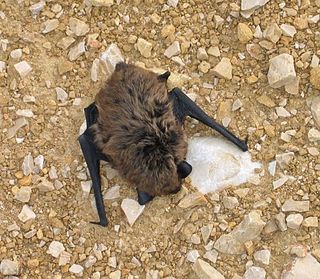
Savi's pipistrelle is a species of vesper bat found across North West Africa, the Mediterranean region and the Middle East. It feeds at night on flying insects. In the summer it roosts under bark, in holes in trees, in old buildings and in rock crevices but in winter it prefers roosts where the temperature is more even such as caves, underground vaults and deep rock cracks.

The cocoi heron is a species of long-legged wading bird in the heron family Ardeidae found across South America. It has predominantly pale grey plumage with a darker grey crest. A carnivore, it hunts fish and crustaceans in shallow water.

The Mohol bushbaby is a species of primate in the family Galagidae which is native to mesic woodlands of the southern Afrotropics. It is physically very similar to the Senegal bushbaby, and was formerly considered to be its southern race. The two species differ markedly in their biology however, and no hybrids have been recorded in captivity.

The forest giant squirrel or Stanger's squirrel is a species of rodent in the family Sciuridae found in Angola, Benin, Burundi, Cameroon, the Central African Republic, the Republic of the Congo, the Democratic Republic of the Congo, Ivory Coast, Equatorial Guinea, Gabon, Ghana, Kenya, Liberia, Nigeria, Rwanda, Sierra Leone, Tanzania, Togo, and Uganda. Its natural habitats are subtropical or tropical moist lowland forests and plantations.
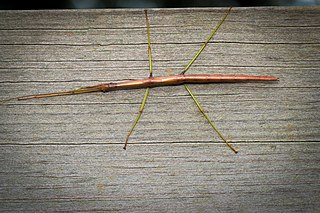
The common walkingstick or northern walkingstick is a species of phasmid or stick insect found across North America. The average length of this species is 75mm (3 in) for males and 95mm (3.7 in) for females.
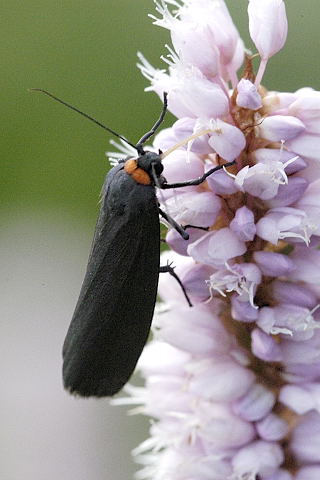
Atolmis rubricollis, the red-necked footman, is a small moth of the family Erebidae. It is found in the summer in forested regions of Europe and Northern Asia. This moth was first described by Carl Linnaeus in his 1758 10th edition of Systema Naturae.

Diploderma swinhonis, also known commonly as the Taiwan japalure, Swinhoe's japalure, Swinhoe's lizard, and Swinhoe's tree lizard, is a species of lizard in the family Agamidae. The species is native to Taiwan. It is considered an invasive alien species in Japan after likely being transported from Taiwan by humans. A foraging ambush predator, this lizard preys primarily on arthropods and thus remains at the bottom of forests perched on trees where sunlight is present. Diploderma swinhonis is not a major threat to humans and is able to adapt to a variety of habitats, including urban environments. Male Diploderma swinhonis are physically distinct from females, with their body sizes being much larger and having a yellow stripe. These lizards sexually reproduce on a seasonal basis and hibernate during the winter time.
Ninox boobook ocellata is a subspecies of the Australian boobook, which is also widely known as the southern boobook. The southern boobook is the most common and smallest owl on the Australian mainland.
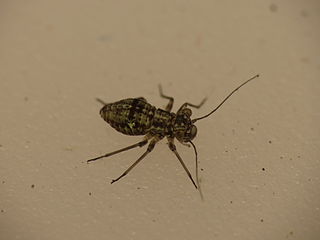
Mesopsocus is a genus of middle barklice in the family Mesopsocidae. There are more than 60 described species in Mesopsocus.


















